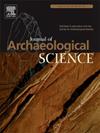从绿到白:中国北方早期白瓷的工艺起源
IF 2.5
1区 地球科学
Q1 ANTHROPOLOGY
引用次数: 0
摘要
隋唐时期中国北方白瓷的出现标志着中国陶瓷历史上一个重要的技术转变。这种发展是如何以及为什么从已经建立的南方青瓷传统中发生的一直是研究人员长期存在的问题。本研究对山西晋阳古城新发现的隋唐窑遗址出土的青瓷、粗白瓷和细白瓷样品进行了成分分析。结果表明,陶瓷体采用了一种富含钙镁的本地粘土。通常采用高钙石灰釉,并根据瓷器类型确定了两种不同的釉料配方。釉料技术遵循两种截然不同的途径:一种是由主体材料和植物灰分共同构成的基础,另一种是用富含硅和铁的材料制成青瓷釉,另一种是用长石矿物制成白瓷釉。这些不同的技术选择表明了一个从模仿到创新的过程。青瓷的制作沿袭了南方的技术,但当地粘土的铁含量较低,因此需要在釉料中添加一种富含铁的材料。这种限制反过来又揭示了当地制造白瓷材料的天然优势,促使人们从昂贵的模仿转向更节约资源的创新。这一变化也推动了浆料精炼、釉料配方和使用密封匣钵烧制方面的改进。金阳的案例揭示了北方白瓷起源背后的一个关键过程:在资源约束和对现有技术的模仿的结合下,本地自主创新。这项工作为了解中国北方白瓷的技术起源和区域差异提供了新的物证。本文章由计算机程序翻译,如有差异,请以英文原文为准。
From green to white: The technological origins of early white porcelain in Northern China
The appearance of white porcelain in Northern China during the Sui and Tang dynasties marks an important technological shift in the history of Chinese ceramics. How and why this development occurred from the established southern celadon tradition has been a long-standing question for researchers. In this study, samples of celadon, coarse white porcelain, and fine white porcelain excavated from a newly discovered Sui-Tang dynasty kiln site at Jinyang Ancient City, Shanxi, were analyzed for their composition. The results show that a local clay rich in calcium and magnesium was used for the ceramic body. A high-calcium lime glaze was commonly applied, and two distinct glaze formulations were identified based on the ware type. The glaze technology followed two distinct pathways: a common base of body material and plant ash was supplemented with either a silica- and iron-rich material to achieve the celadon glaze, or with a feldspathic mineral to develop the white porcelain glaze. These different technical choices indicate a progression from imitation to innovation. Celadon production followed southern techniques, but the low iron content of local clays required the addition of an iron-rich material to the glaze. This limitation, in turn, revealed the natural advantages of the local materials for making white porcelain, prompting a move from costly imitation toward more resource-efficient innovation. This change also drove improvements in paste refinement, glaze formulation, and the use of sealed saggers for firing. The case of Jinyang reveals a key process behind the origin of northern white porcelain: local, independent innovation was driven by a combination of resource constraints and the imitation of existing technologies. This work provides new physical evidence for understanding the technological origins and regional variations of white porcelain in Northern China.
求助全文
通过发布文献求助,成功后即可免费获取论文全文。
去求助
来源期刊

Journal of Archaeological Science
地学-地球科学综合
CiteScore
6.10
自引率
7.10%
发文量
112
审稿时长
49 days
期刊介绍:
The Journal of Archaeological Science is aimed at archaeologists and scientists with particular interests in advancing the development and application of scientific techniques and methodologies to all areas of archaeology. This established monthly journal publishes focus articles, original research papers and major review articles, of wide archaeological significance. The journal provides an international forum for archaeologists and scientists from widely different scientific backgrounds who share a common interest in developing and applying scientific methods to inform major debates through improving the quality and reliability of scientific information derived from archaeological research.
 求助内容:
求助内容: 应助结果提醒方式:
应助结果提醒方式:


